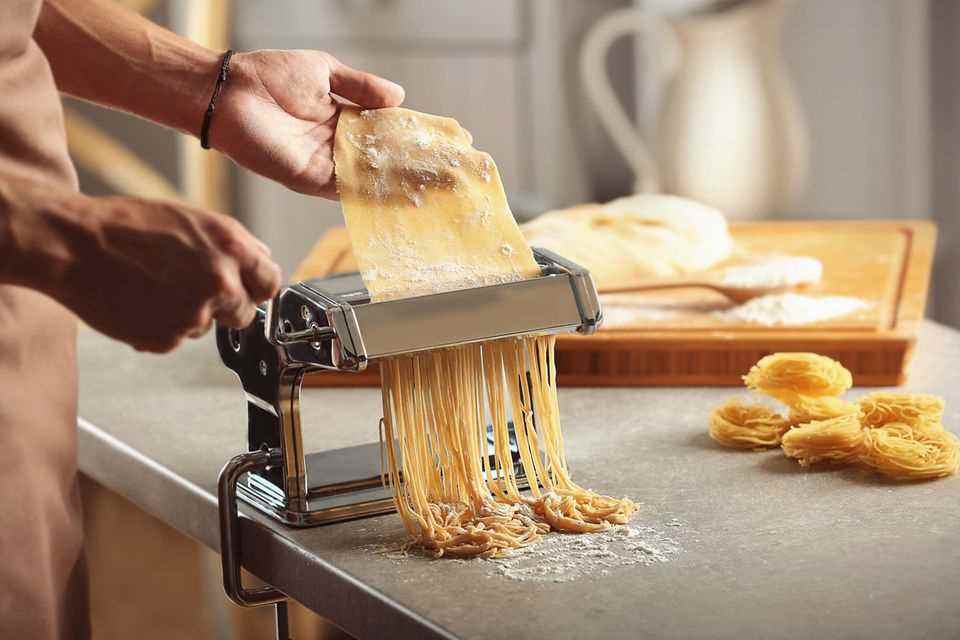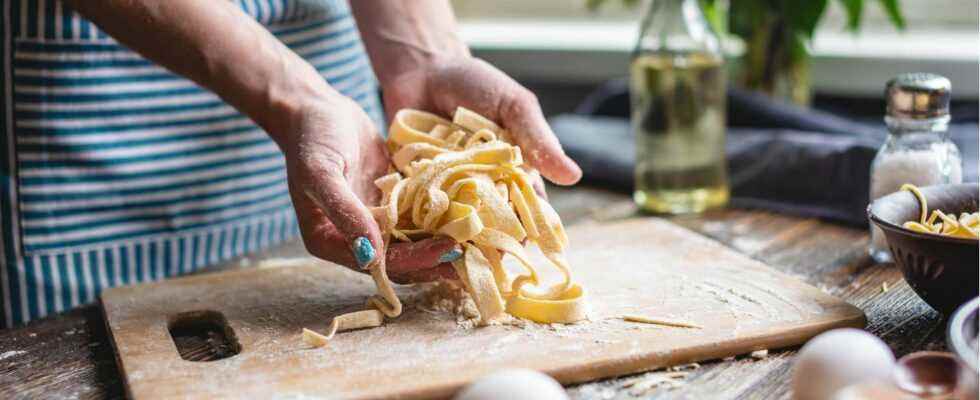Make your own noodles
This is how perfect pasta dough succeeds with and without a pasta machine
© Artem / Adobe Stock
We love them in every form and variety: Pasta. And because fresh pasta tastes best, we’ll show you how to make pasta yourself.
Penne, farfalle, ravioli, linguine, rigattoni, cannelloni or fusilli – there seems to be an infinite number of types of pasta and therefore just as many options as you can imagine Make your own noodles can. And almost as many good reasons: you know exactly what’s in it, you can use regional and fresh ingredients, you save on packaging material and hard cash, and it’s a lot of fun!
And, already convinced? We will now show you how easy it is to make pasta dough with or without a pasta machine, to create any shape and to serve the homemade pasta with your favorite sauce.
What do you need to make pasta yourself?
In order to be able to make pasta yourself, you don’t actually need much and the best thing is that you always have the required ingredients at home.
These utensils are required:
- pasta machine or rolling pin
- Flour, water and salt (possibly durum wheat semolina, oil and eggs)
- sharp knife or pastry wheel
- kitchen towel or a pasta dryer/pasta stand
- large pot + colander
Classic pasta dough: the ingredients
The classic pasta dough requires only a few ingredients: Flour, water, some oil and salt. But which flour is suitable for pasta? Best you take Italian durum wheat flour (Type 00)but also with normal Wheat Flour (Type 405 or 550), a good pasta dough succeeds. If you want to make noodles with regular wheat flour, you can use that too 50:50 with durum wheat semolina be mixed. This gives the dough an even better consistency.
Tip: If you want something a little healthier: simply replace wheat flour and durum wheat semolina with wholemeal or spelled flour. Gluten-free alternatives include lentil, chickpea, buckwheat or rice flour.
Make your own pasta dough: 5 basic recipes
Noodles with pasta flour
ingredients for 4 persons
- 400 g Italian durum wheat flour type 00
- ½ tsp salt
- 2 tsp olive oil
- 150ml of water
Noodles with wheat flour
ingredients for 4 persons
- 400 g wheat flour type 405
- ½ tsp salt
- 2 tsp olive oil
- 150ml of water
Pasta with wheat flour and durum wheat semolina
ingredients for 4 persons
- 200 g wheat flour type 405
- 200 g durum wheat semolina
- ½ tsp salt
- 2 tsp olive oil
- 150ml of water
Noodles with egg
ingredients for 4 persons
- 400 g Italian durum wheat flour type 00 (or 200 g wheat flour + 200 g durum wheat semolina)
- 4 eggs
- ½ tsp salt
- 2 tsp olive oil
Tip: For pasta with eggs, 1 egg and 100 grams of flour per person is usually used.
Gluten free pasta
ingredients for 4 persons
- 240 grams of buckwheat flour
- 160 g potato starch
- 40 grams of flaxseed flour
- 160ml water
preparation
The preparation steps are the same for all the basic recipes mentioned.
- Put all the ingredients in a mixing bowl and knead into a dough with the dough hook of the mixer.
- Then place on a floured work surface and knead with your hands for about 10 minutes to form a smooth dough. Repeatedly press the dough apart with the heels of your hands, fold it together and continue kneading. The dough should be kneaded until it is elastic, has a shiny surface and is no longer sticky. Tip: The pasta dough should be easy to work with. If your dough is too firm, add a little oil or a tablespoon of water, if it’s too sticky, add some flour or durum wheat semolina to the dough and knead it well again.
- Form the dough into a ball, wrap in cling film and leave to rest in the fridge for at least half an hour.
Preparation with pasta machine © Africa Studio / Adobe Stock
- Knead the dough again with your hands, divide into 4 parts and turn them one by one through the widest opening of the pasta maker. Leave the remaining pieces of dough wrapped in the foil and pack them back in the fridge until you work them, so that the rest of the dough does not cool down during this time dries up.
- Then tighten the roller opening with each pass and roll the dough through again. As soon as your pasta sheets get too long, you can simply cut them in half with a knife and continue working with the individual sections in stages. Don’t forget to dust the rollers of the machine with flour from time to time, otherwise the dough will stick to them.
- Repeat this process until the pasta dough has reached the desired thickness.
- Then process the pasta dough as you wish, for example turning it through the cutting rollers to get long tagliatelle or linguine.
Preparation without a pasta machine
- Knead the pasta dough again with your hands, cut into quarters and work on the sections one by one. It is best to wrap the rest in cling film again so that it does not dry out.
- Roll out the piece of dough on a floured work surface with a floured rolling pin from the center outwards to a thickness of about 0.5-1 cm. Process the pasta dough as you wish. For example, you can use a rolling pin or a sharp knife to make ribbon noodles, cut lasagne sheets or cut out ravioli.
cook noodles
- If you want to cook the noodles right away, simply put them in a saucepan with plenty of salted water and cook them for 1-3 minutes (depending on the thickness of the noodles). The noodles are done when they float to the top.
Make your own pasta with a pasta machine
If you like it easy, you can use a pasta machine to make pasta yourself. You have the choice between one manual pasta machine and one electric pasta machine. While you still have to apply the right muscle power for rolling with the manual one, the motor does the work with the electric one. In addition to the lower physical exertion, the exact dough thickness is also a big advantage of pasta machines. Because the calibrated pasta machine allows you to precisely adjust the thickness of the pasta dough.
Make pasta yourself without a pasta machine
A pasta machine makes the work easier, but it is not absolutely necessary. Particularly flat, elongated types of pasta such as linguine, tagliatelle or fettuccine, but also filled pasta such as ravioli or tortellini can be easily prepared without a machine.
If you don’t have a pasta machine, roll out the dough with a rolling pin and then cut it into the desired shape with a knife or pastry wheel. Depending on the type of pasta you want to prepare, you will also need a cutter (e.g. for ravioli) or wooden sticks for fusilli. To prevent the noodles from sticking together, dust them with enough flour and let them dry on a kitchen towel or wooden stand a little apart from each other.
Tip: In order to get a manual pasta machine clean quickly and easily, you have to let it dry well after use, then turn the crank so that dough residue falls out and simply wipe all parts with a cloth or brush. We would not recommend soap and water to avoid dulling the roller over time.
Easy peasy: Blitznoodles without rolling them out
For those in a hurry, we recommend ours Blitznoodles. They work without rolling them out or using a pasta machine. Simply form finger-thick rolls of dough from your pasta dough and press them flat with a wide knife blade or a wooden board. Then cut the dough into thin strips. This way you get handy noodles or if you put two short strips together in parallel and twist them against each other, you can even make unusual Gemelli.
Dry and store homemade pasta
If you noodles prepare in advance If you want, you can either lay them out on tea towels or hang them over a pasta dryer. When not in use, it folds flat and stows away to save space. When the noodles are well dried, it is best to put them in one tin can or in a sealable jar. As long as they remain airtight and are completely dry, they’re good 2-3 months shelf life.
Pasta with or without egg?
The main difference between pasta with and pasta without eggs is the taste and consistency. Fresh egg noodles taste a little more aromatic and the dough is a little firmerwhile Noodles without egg are softer after cooking. Depending on the type of pasta you want to prepare, it is advisable to use pasta dough with egg for making tagliatelle, fettuccine or pappardelle, for example. The addition of eggs also increases the stickiness of the dough, which is why dough with egg is also ideal for making filled pasta such as ravioli or tortellini.
Pasta with durum wheat semolina or without?
Durum wheat semolina has a high gluten content. The gluten protein makes the noodles more flexible when dry and they don’t break as easily. In addition, the homemade pasta is easier to cook al dente (al dente) with durum wheat semolina. Pasta dough with a 1:1 mixture of wheat flour and durum wheat semolina or Italian pasta flour (durum wheat flour) Type 00 is therefore best suited for spaghetti, penne, rigatoni and fusilli.
Delicious pasta recipes

